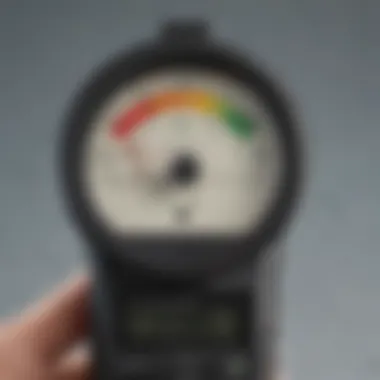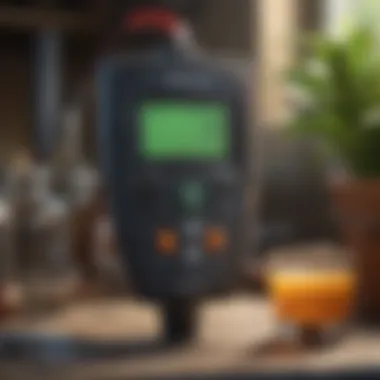Affordable pH Meters for Agricultural Use


Intro
In modern agriculture, the management of soil pH is crucial. It affects plant growth, nutrient availability, and overall yield. For farmers and horticulturists, having an accurate pH meter can mean the difference between a successful crop and a failed one. The goal of this article is to provide a comprehensive guide on inexpensive pH meters that deliver reliable measurements without straining budgets.
Understanding pH meters is essential for various agricultural applications. Affordable options are available, making it accessible for all practitioners, whether they are experienced professionals or hobbyists. This guide will equip readers with knowledge on features, comparisons, and maintenance tips to aid in selecting the best pH meter for their specific needs.
Topic Overview
Definition and Importance
A pH meter is an electronic device used to measure the acidity or alkalinity of a solution. It provides readings on a scale from 0 to 14, with 7 being neutral. Values below 7 indicate acidity, whereas values above 7 indicate alkalinity. In agriculture, monitoring soil pH is vital because it influences nutrient availability. For example, certain nutrients become more soluble in specific pH ranges. Therefore, knowing the pH level allows farmers to adjust their soil management practices accordingly, enhancing crop quality and yield.
Brief History and Evolution
The concept of measuring soil pH has evolved significantly. Early methodologies relied on litmus paper and colorimetric techniques. These methods were often inaccurate and required subjective interpretation. The introduction of electronic pH meters in the 1930s revolutionized the field. Over the years, advancements have led to the development of pocket-sized models that are user-friendly and cost-effective. Today, a wide range of pH meters exists, suitable for both personal and commercial agricultural use.
Key Techniques and Innovations
Sustainable Farming Practices
Utilizing pH meters can greatly contribute to sustainable farming practices. By accurately measuring soil pH, farmers can apply organic fertilizers and amendments more judiciously. This helps reduce chemical runoff and promotes healthier soil ecology. Furthermore, these practices can lead to longer-term soil fertility, benefiting future crops.
Advanced Agronomic Technologies
Innovation in agricultural technologies has also enabled more precise pH measurements. Digital pH meters now come equipped with advanced sensors that improve accuracy and response time. Some models connect to mobile apps for data tracking, allowing farmers to analyze trends over time. This integration of technology aids in making informed decisions based on historical data.
Practical Applications
Step-by-Step Guides
When using a pH meter, it's essential to follow specific steps to ensure accurate results:
- Preparation: Clean the electrode with distilled water. This removes any previous samples that may skew results.
- Calibration: Calibrate the meter using standard buffer solutions to ensure accuracy.
- Measurement: Insert the electrode into the soil or liquid sample, ensuring it's adequately submerged. Wait for stability in the reading.
- Recording: Note the reading and compare it with optimal pH levels for the specific crops being grown.
Case Studies or Real-World Examples
For instance, a study on tomato production showed that farmers who routinely monitored soil pH achieved healthier plants and higher yields. One participant invested in a basic pH meter and adjusted their fertilizer application based on the readings, resulting in a significant increase in crop output over the growing season.
Regular monitoring of pH can lead to better nutrient management strategies, resulting in healthier plants and improved harvests.
Preamble to pH Meters
Understanding pH meters is crucial for anyone involved in agriculture or horticulture. These instruments measure the acidity or alkalinity of a solution, which is essential for optimal plant growth. Soil and water pH significantly impact nutrient availability, plant health, and overall yield. Choosing the right pH meter can make a difference in agricultural outcomes.
Benefits of Using pH Meters
pH meters provide precise measurements. Unlike litmus paper, they offer numerical values that can guide decisions in soil management and crop planning. Regular pH testing can help in adjusting soil conditions to meet specific crop needs. Moreover, with various affordable options available, even small-scale farmers can access this valuable technology.
Considerations for pH Meter Selection
When selecting a pH meter, accuracy, ease of use, and price are significant factors. Not all pH meters are created equal; some offer features that suit particular applications better than others. Understanding how to use these meters and interpreting the results is equally important. A well-informed decision ensures better soil and water management, leading to more productive farming practices.
Understanding pH and Its Importance
The pH scale ranges from 0 to 14, with seven being neutral. Values below seven indicate acidity, while values above seven signify alkalinity. Each plant species prefers a certain pH range. For instance, most vegetables thrive in slightly acidic soils, around 6.0 to 6.8.


Monitoring soil pH can indicate nutrient deficiencies. For instance, iron becomes less available to plants when the pH is above 7.1. Regular checks can help mitigate such issues, allowing for timely amendments to maintain ideal conditions.
Applications of pH Meters in Agriculture
In agriculture, pH meters find use in various contexts:
- Soil Testing: Farmers test soil before planting to adjust pH accordingly. This ensures nutrient availability for seedlings.
- Water Quality Monitoring: Irrigation water must be within an ideal pH range to maximize crop health.
- Fertility Management: pH affects nutrient solubility. By knowing the pH, farmers can decide on fertilizers that will best meet their crops' needs.
In summary, pH meters play an integral role in modern farming. By understanding their operation and strategic applications, farmers can enhance their practices and yield.
Criteria for Evaluating Inexpensive pH Meters
Evaluating inexpensive pH meters requires a thoughtful approach. This is vital because a poor selection can lead to inaccurate readings, affecting agricultural success. Choosing the right pH meter ensures that soil conditions are optimal for plant health. In this section, we focus on several key factors that impact the performance of budget-friendly pH meters. Understanding these criteria will assist users in making informed choices and maximizing their investments.
Accuracy and Precision
Accuracy refers to how close a measured value is to the true value. Precision reflects the consistency of repeated measurements. Both are crucial when selecting a pH meter. A device that offers high accuracy and precision minimizes errors in readings. For growers, this means more reliable data that can directly influence planting decisions and adjustments. Carefully checking specifications and user feedback helps gauge a meter's performance in real situations.
Calibration Process
Calibration ensures the pH meter provides correct readings. It involves setting the meter to known pH standards before taking actual measurements. Users should look for a meter that is easy to calibrate. Many of these devices come with simple instructions, making calibration straightforward. Regular calibration also contributes to maintaining measurement accuracy over time. For best results, calibrate using fresh standards and aim to do so often, especially if the meter is used frequently.
Build Quality and Durability
A pH meter's build quality influences its longevity and reliability. Good durability can prevent damage during fieldwork or transport. Farmers should look for meters made from high-quality materials that can endure harsh conditions. Additionally, some meters have replaceable electrodes, which increases their lifespan and value. Prioritizing durability is wise; it can save money and time in the long run.
User-Friendliness
User-friendliness is key for effective operation. A straightforward interface can save users from unnecessary confusion. Simple buttons and clear displays make it easier to read measurements. Meters that come with instructional materials, whether in printed format or online support, facilitate users in understanding how to operate them efficiently. Features such as automatic shut-off and backlit displays also enhance usability.
Portability and Design
Portability refers to how easy it is to carry and use the pH meter in various environments. A lightweight design can make a significant difference for users who travel to different locations for testing. Look for compact options or those with protective cases. Ergonomic designs contribute to easier handling, especially in outdoor scenarios. When the design is appropriate, it enhances the entire user experience, encouraging regular measurements.
Top Recommendations for Inexpensive pH Meters
When evaluating the best inexpensive pH meters, it is crucial to focus on specific elements that define their value. Affordable options can still offer quality performance and reliability, which is essential for accurate measurements in agriculture. Features such as portability, user-friendliness, and durability are paramount. Moreover, understanding the context and an appropriate application for each meter supports better decision-making.
Investing time in comparing various models allows farmers and horticulture enthusiasts to find a pH meter that suits their needs without exceeding their budget. The following sections delve into particular models that exemplify these criteria.
Model A: Features and Performance
Model A, the Hanna Instruments HI 98107, stands out in the budget category due to its simplistic design and effectiveness. This model is known for its accuracy in measuring pH levels, typically within a range of 0.00 to 14.00 pH, making it suitable for both soil and water testing. One of its remarkable features is its automatic temperature compensation, allowing users to obtain correct readings across different temperatures. The compact design also enhances portability, enabling users to carry it conveniently.
The Hanna HI 98107 has a straightforward interface with an easily readable LCD display. Calibration is user-friendly and can be done with just a few adjustments at home or in the field. Overall, this model proves to be an excellent choice for beginners and seasoned farmers alike, seeking reliable results without a hefty price tag.
Model B: Features and Performance
Another noteworthy option is the Bluelab pH Pen. This model is favored for its robust build quality and precision. With a measurement range of 0.0 to 14.0 pH, the Bluelab pH Pen ensures that the results are consistent across various conditions. One significant advantage of this meter is its dual display, which provides simultaneous readouts for pH and temperature.
Moreover, the Bluelab pH Pen features easy calibration and comes with a stored memory function, allowing users to check previous readings. The design focuses on user-friendliness, with a water-resistant body, ideal for fieldwork. Given its durability and functionality, this model appeals to users who demand accuracy with minimal maintenance requirements.
Model C: Features and Performance


The Apera Instruments AI209 offers a combination of performance and value, making it a strong contender among inexpensive pH meters. This model boasts a fast response time and accuracy within ±0.1 pH. Its LCD is equipped with a backlight that enhances visibility in low-light conditions.
What distinguishes the Apera AI209 is its replaceable sensor, which means users can extend the life of the meter without purchasing an entirely new unit. Its waterproof design and ergonomic grip make it easy to handle in various environments. This pH meter serves as a reliable tool for both beginners and advanced users, particularly those looking for a feature-rich meter at a reasonable price.
"The right pH meter can transform your agricultural practices, ensuring optimal growth conditions for crops. Choose wisely to make the most of your investment."
Comparative Analysis of Recommended pH Meters
A comparative analysis of recommended pH meters is crucial for anyone looking to invest in affordability without sacrificing quality. This section outlines key factors such as price, features, and user-friendliness which ensure that you select the device that fits your specific needs.
This analysis not only highlights the differences between models but also helps to demystify the complexities around pH measurement. By examining various inexpensive pH meters side by side, users can make informed decisions tailored to their agricultural or horticultural practices.
Price vs. Features
In the realm of pH meters, price often reflects features. However, this does not mean that a higher price guarantees a better product. Many budget-friendly options offer essential features that cater to the needs of beginners and seasoned users alike.
When evaluating price versus features, consider the following:
- Calibration range: Some models provide wider ranges, while others may be limited. This is critical for precise measurements.
- Display type: LCD screens are common, but some devices include backlit options for better visibility.
- Sensor quality: A high-quality sensor often improves durability and measurement accuracy.
Finding the right balance can help avoid overspending, while still obtaining a reliable tool. Researching the specifications thoroughly is recommended for optimal results.
Best Options for Beginners
Beginners often require straightforward instruments that deliver accurate readings without extensive prior knowledge. Selecting a user-friendly meter is vital. Here are a couple options ideal for novice users:
- Hanna Instruments HI 98107: This model is simple to use, featuring a straightforward calibration process. It gives accurate readings, which is perfect for those new in the field.
- Bluelab pH Pen: This device is portable and equipped with a clear digital display. It guides users through calibration and has an affordable price point.
Both options emphasize simplicity and effectiveness, ensuring that beginners can start measuring pH with confidence.
Best Options for Advanced Users
On the opposite end of the spectrum, advanced users often seek features that allow for more control and flexibility in measurements. Here are some suggested pH meters for more experienced individuals:
- Apera Instruments AI209: Packed with advanced capabilities, this meter offers automatic temperature compensation and data logging features. It suits those who need precision and detail in pH analysis.
- Milwaukee MW102: This model provides high accuracy and various calibration points. Its design appeals to users who need higher-level functionality.
These meters cater to users looking to perform detailed analysis and provide more nuanced control over their pH testing.
"Choosing the right pH meter involves understanding your specific needs and aligning them with the available features and budget constraints."
By understanding the comparative aspects of these devices, buyers can easily navigate the market and select the right meter for their needs.
Maintenance and Care of pH Meters
Maintaining a pH meter is essential for ensuring accurate readings and long-term performance. Regular care helps to prevent damage and extends the device's lifespan. Taking these measures can save time and cost in the long run, making it a necessary practice for anyone involved in agriculture or horticulture. Proper maintenance involves routine checks, calibration, and careful storage. Each of these components plays a role in ensuring that a pH meter operates at its best.
Routine Maintenance Practices
Routine maintenance of pH meters is vital to ensure reliability and precision. Keeping the probe clean is one of the first steps. A dirty probe can lead to incorrect readings. After each use, the electrode should be rinsed with distilled water. Avoid using tap water, as it may contain minerals that can interfere with pH readings.
Furthermore, periodically check the condition of the electrode. Signs of wear or damage, such as cracks, indicate that the probe may need to be replaced. Some meters allow the replacement of probes, which can be more cost-effective than buying a new meter. To maintain optimal performance, it is also important to check the calibration regularly.


Proper Calibration Procedures
Calibration is a critical process that ensures the accuracy of your readings. It is best to perform calibration before every use, especially if the meter has not been used for a while. Follow the manufacturer’s guidelines for calibration, which typically involve using at least two pH standard solutions.
Begin by immersing the probe into the first standard solution, usually at pH 7.0, and adjust the reading accordingly. After achieving accuracy at the first point, rinse the probe and then repeat the process with a second standard solution, often at pH 4.0 or pH 10.0. Completing this two-point calibration solidifies reliable performance across the pH range.
"Calibration ensures the accuracy of pH meters, significantly influencing agricultural outcomes."
Storage Recommendations
Proper storage of pH meters is just as important as maintenance measures. After use, store the meter in a suitable environment. Some pH meters have caps or storage solutions that should be used to keep the probe wet. If the probe dries out, it can lose sensitivity and accuracy.
It is advisable to store the pH meter in a protective case to prevent physical damage. Furthermore, ensure that the storage location is clean and free from extreme temperatures. Avoid excessive humidity, as it can damage electronic components.
By observing these maintenance and care strategies, pH meter users can ensure the longevity and efficacy of their devices, which is vital in achieving accurate soil and solution assessments.
Common Challenges and Solutions
In the pursuit of accurate and reliable pH measurement, users often encounter several challenges. Understanding these challenges and their solutions is vital for anyone utilizing pH meters, especially for those in agriculture. This section addresses common issues and provides practical solutions, empowering users to maximize the effectiveness of their equipment.
Understanding pH Drift
pH drift refers to the gradual change in pH readings over time, often due to various factors affecting the sensor's performance. This phenomenon can lead to inaccurate results if not recognized and corrected promptly. pH drift typically stems from temperature fluctuations, electrode wear, or contamination of the sensor.
- Temperature shifts can alter the pH of a solution, leading to unreliable readings. It is crucial to perform measurements at consistent temperatures to minimize this issue.
- Electrode wear occurs naturally over time, particularly with frequent use. Old or damaged electrodes may produce inconsistent results.
- Contamination is another factor; any foreign substance on the electrode can compromise its function, generating false readings.
Regular monitoring of the pH meter's performance can help. Users should frequently calibrate their device to ensure accurate measurements. Also, keeping electrodes clean and replacing them as needed will mitigate the effects of drift. For individuals engaged in soil testing, understanding the factors contributing to pH drift is essential for maintaining the reliability of readings.
Addressing Calibration Errors
Calibration is a critical process in ensuring the accuracy of the pH meter. However, users may encounter errors during calibration, leading to incorrect pH readings. These inaccuracies can arise from several sources, such as using expired calibration solutions, improper technique, or neglecting to perform calibration regularly.
To address calibration errors effectively, users can follow these guidelines:
- Choose Fresh Calibration Solutions: Using expired solutions can skew results. Always ensure that calibration buffers are within their shelf life and properly stored.
- Calibrate Regularly: Implement a routine calibration schedule. Depending on the frequency of use, calibrating before each measurement session may be necessary to ensure accuracy.
- Follow Instructions Carefully: Each pH meter may have specific calibration requirements. Following the manufacturer’s instructions closely can prevent errors and improve the reliability of results.
- Perform Multilevel Calibration: Whenever possible, calibrate using at least two points, usually at pH 4.0 and pH 7.0. This helps to enhance the accuracy across the range of expected measurements.
By actively addressing common calibration errors, users can greatly improve their pH measurement reliability, enhancing the overall effectiveness of their pH meters in agricultural applications.
Epilogue and Final Thoughts
In the realm of agriculture, monitoring soil pH is critical for achieving optimal plant growth and maximizing crop yield. This article underscores the significance of selecting an inexpensive pH meter that balances cost and effectiveness. The insights provided throughout this piece serve not just to aid in the purchase decision but to also foster an understanding of how pH values impact overall agricultural health.
Understanding the nuances of pH meters can make a difference in farming practices. Readers now have a clearer perspective on necessary features such as accuracy, calibration ease, and user-friendliness that distinguish a good pH meter from a mediocre one. Investing in the right tools ensures farmers can analyze their soil effectively, leading to better-informed decisions regarding their crop management strategies.
Moreover, as technology advances, embracing new features and enhancements allows you to stay ahead in your farming efforts. Understanding these shifts leads to better preparation and adaptation in agricultural practices, ultimately promoting sustainability.
"Selecting the right pH meter is not just about measurement; it is about understanding the foundation of healthy crop production."
Recap of Key Points
- Understanding pH Importance: Soil pH levels are pivotal for nutrient availability.
- Evaluating Meters: Key factors include accuracy, calibration processes, and durability.
- Recommendations: Various models were analyzed to fit different user needs.
- Maintenance: Regular care prolongs the meter's lifespan and ensures reliable readings.
- Challenges: Common issues like drift and calibration were addressed with potential solutions.
Future Trends in pH Meter Technology
The future of pH meter technology promises enhancements that will further streamline agricultural practices. Digital advancements suggest that we will see pH meters becoming more user-centric, possibly equipped with smartphone connectivity for data logging and analysis.
Moreover, integration with IoT (Internet of Things) can enable real-time monitoring and remote data access. This evolving landscape can provide farmers with information instantaneously, enabling quicker decision-making.
As such innovations emerge, it is crucial for users to stay informed and adaptable. Informed farmers will be better positioned to fully utilize advancements, enhancing both productivity and sustainability in their agricultural practices.



